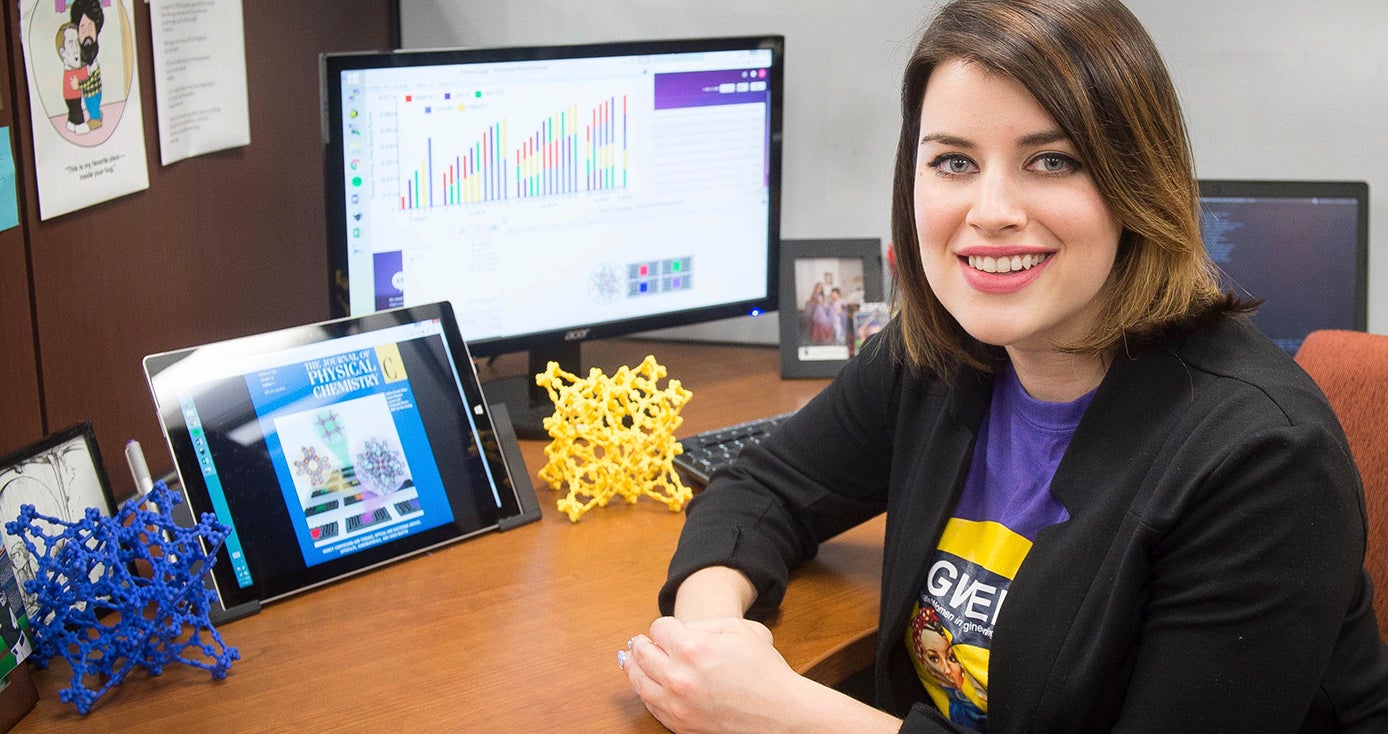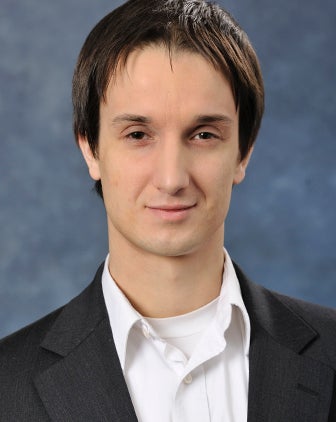
Subscribe to Pittwire Today
Get the most interesting and important stories from the University of Pittsburgh.Researchers Have ‘Nose’ For Sensory Tech
Imagine being able to smell a disease before it’s formally diagnosed or sniffing a minor gas leak before a catastrophic explosion occurred.
University of Pittsburgh doctoral student Jenna Gustafson is on the case, investigating porous materials that can sense scents, with assistant professor Christopher Wilmer at the Swanson School of Engineering.
The duo is developing artificial “noses” that could someday detect minute traces of gases like deadly carbon monoxide that current technology has trouble sniffing out. As part of those efforts, they have been researching sponge-like materials that can soak up gases at the atomic scale. The technology uses porous materials to absorb whatever smells are wafting through the air to provide accurate measurements. These materials are made from tiny nanocrystalline structures with high absorption properties, which can better pick up trace amounts of gas.
“We’re employing these different structural and physical properties of various sponge-like materials’ structures and physical properties to create a better sensor,” Gustafson said. While no physical device has been created for this project, future “noses” could manifest as anything from a prosthetic to a microchip in a cell phone or smart watch.
This early research in the Wilmer Lab, if successful, would improve the sensitivity of current sensing technology as well as its ability to differentiate between different noxious smells.
Beyond smelling, Wilmer's lab also works on using the same sponge-like materials to filter gases. Wilmer said that current technologies, such as those used in gas masks, use a “one-shoe-fits-all” material for all filtration. Current masks often use activated carbon to keep fumes like ammonia gas in fertilizers away from the user.
“Activated carbon doesn’t work very well for more dangerous gases,” Wilmer said. “If we can design specific-gas sponge materials that can soak up, say, ammonia or mustard gas in layers, then you could have a gas mask that could be perfect to protect you from things you might run into.”
Knowing more precise levels of gases could also be important in rescue situations.
“A carbon monoxide or smoke detector in your home alerts you once you reach a certain limit,” Gustafson said. But “if there is a really low concentration of something even more dangerous, you would need a sensor that could be more selective about the compounds being detected."
Wilmer likened other uses of the nanotech to some dogs’ ability to sense disease in humans.
“There have been reported cases of dogs being able to determine whether patients have Parkinson’s disease, lung cancer or skin cancer just by smelling them,” Wilmer said. “If we had an electronic device that could smell as well as dogs can, we could detect these diseases.”
For her dedication to the artificial nose project, Wilmer has called Gustafson a “very talented researcher” and a “natural leader.”
“From numerous undergraduates to senior scientists at national labs, Jenna has done an excellent job channeling everyone's contributions toward the end goal: a functional electronic nose,” Wilmer said. “I am excited to see where she takes the project next.”
Wilmer's work earns high praise
Wilmer is the principal investigator of the Hypothetical Materials Lab at Pitt and leads his team in solving energy and environmental challenges with porous nanostructures called metal-organic frameworks.
He earned his bachelor’s degree in applied science at the University of Toronto and his doctorate in chemical engineering at Northwestern University.
While at Northwestern, Wilmer took an interest in entrepreneurship and co-founded a company called NuMat Technologies, which designs porous materials that could be used to make better natural-gas fuel tanks for vehicles. In 2012, the company won the Department of Energy’s National Clean Energy Business Plan Competition, and Wilmer was named to Forbes’ “30 Under 30 in Energy.” He has authored more than 25 publications, and his research has been cited more than 3,000 times.
Wilmer was also recently named a recipient of the Young Investigator Award for Modeling and Simulation by the American Institute of Chemical Engineers for his research on materials for gas filtration, such as gas masks, and sensing and storage technologies like the artificial nose.
“The Young Investigator Award is one of the most prestigious honors in chemical engineering simulation and modeling, and truly reflects the breadth and depth of Chris’ career over such a short period,” said Steven Little, the William Kepler Whiteford Professor and Chair of the Department of Chemical and Petroleum Engineering.
Gustafson said working with Wilmer has been a “great learning experience.”
“He encourages us to work on projects which we are passionate about, in addition to our main research, and wants us to take the time to learn skills that will benefit us when looking for jobs after we graduate,” Gustafson said. “He wants all of us to reach higher and push ourselves when it comes to what is possible in science, engineering and entrepreneurship. Chris has a unique vision, and we are all very lucky to work with and learn from him.”



